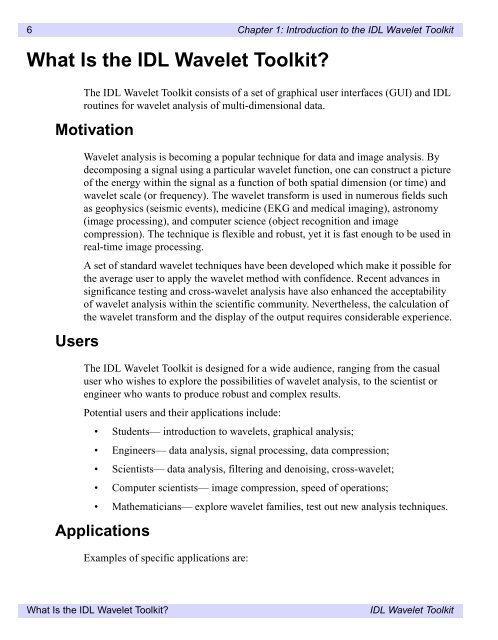IDL Wavelet Toolkit User's Guide
IDL Wavelet Toolkit User's Guide
IDL Wavelet Toolkit User's Guide
Create successful ePaper yourself
Turn your PDF publications into a flip-book with our unique Google optimized e-Paper software.
6 Chapter 1: Introduction to the <strong>IDL</strong> <strong>Wavelet</strong> <strong>Toolkit</strong>What Is the <strong>IDL</strong> <strong>Wavelet</strong> <strong>Toolkit</strong>?The <strong>IDL</strong> <strong>Wavelet</strong> <strong>Toolkit</strong> consists of a set of graphical user interfaces (GUI) and <strong>IDL</strong>routines for wavelet analysis of multi-dimensional data.MotivationUsers<strong>Wavelet</strong> analysis is becoming a popular technique for data and image analysis. Bydecomposing a signal using a particular wavelet function, one can construct a pictureof the energy within the signal as a function of both spatial dimension (or time) andwavelet scale (or frequency). The wavelet transform is used in numerous fields suchas geophysics (seismic events), medicine (EKG and medical imaging), astronomy(image processing), and computer science (object recognition and imagecompression). The technique is flexible and robust, yet it is fast enough to be used inreal-time image processing.A set of standard wavelet techniques have been developed which make it possible forthe average user to apply the wavelet method with confidence. Recent advances insignificance testing and cross-wavelet analysis have also enhanced the acceptabilityof wavelet analysis within the scientific community. Nevertheless, the calculation ofthe wavelet transform and the display of the output requires considerable experience.The <strong>IDL</strong> <strong>Wavelet</strong> <strong>Toolkit</strong> is designed for a wide audience, ranging from the casualuser who wishes to explore the possibilities of wavelet analysis, to the scientist orengineer who wants to produce robust and complex results.Potential users and their applications include:• Students— introduction to wavelets, graphical analysis;• Engineers— data analysis, signal processing, data compression;• Scientists— data analysis, filtering and denoising, cross-wavelet;• Computer scientists— image compression, speed of operations;• Mathematicians— explore wavelet families, test out new analysis techniques.ApplicationsExamples of specific applications are:What Is the <strong>IDL</strong> <strong>Wavelet</strong> <strong>Toolkit</strong>?<strong>IDL</strong> <strong>Wavelet</strong> <strong>Toolkit</strong>
















